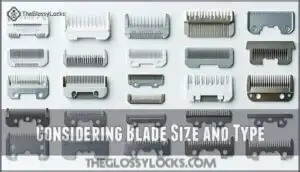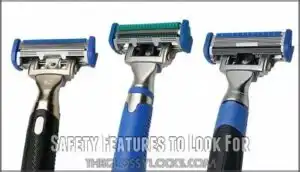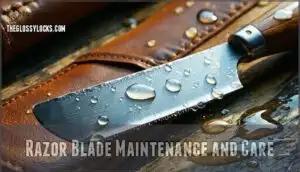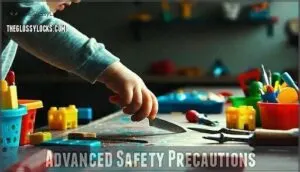This site is supported by our readers. We may earn a commission, at no cost to you, if you purchase through links.
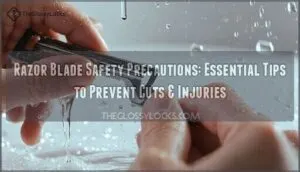
Store blades in protective cases or magnetic strips, away from children and pets. Replace dull blades immediately—they’re more dangerous than sharp ones because they require extra pressure.
Never catch a falling razor, and always cut away from your body. Clean blades after each use to prevent bacterial buildup.
The difference between a safe shave and a trip to urgent care often comes down to mastering these fundamental techniques and understanding which specific mistakes cause the most injuries.
Table Of Contents
- Key Takeaways
- Razor Blade Safety Basics
- Choosing Safe Razor Blades
- Safe Handling Techniques
- Preventing Cuts and Injuries
- Razor Blade Maintenance and Care
- Advanced Safety Precautions
- Frequently Asked Questions (FAQs)
- What are the blade safety precautions?
- What safety precautions should be used when cutting using a razor?
- What precautions should be taken when working with sharp knives?
- What are 5 safety points to remember when working with knives?
- Can razor blades be recycled or reused?
- How often should razor blades be replaced?
- Are electric razors safer than manual blades?
- What medical conditions affect razor blade safety?
- Do different blade brands have varying sharpness?
- Conclusion
Key Takeaways
- Master proper grip techniques – You’ll prevent most accidents by using the pinch technique with your thumb and forefinger, maintaining a 30-degree blade angle, and keeping firm but flexible pressure while always cutting away from your body.
- Replace dull blades immediately – You’re more likely to get injured with a dull blade than a sharp one because it requires extra pressure and can slip or snag, so watch for tugging, uneven cuts, or rust as warning signs.
- Store and dispose of blades safely – You’ll protect yourself and others by keeping blades in protective cases away from children and pets, using puncture-proof disposal containers, and never overfilling disposal units beyond two-thirds capacity.
- Stay focused and use protective gear – You can’t afford distractions when handling razor blades, so wear cut-resistant gloves, maintain a clutter-free workspace, and never rush through tasks that require precision and control.
Razor Blade Safety Basics
You’ll handle razor blades safely when you master three core principles: proper grip techniques, immediate disposal after use, and maintaining sharp, clean blades that won’t snag or slip.
These fundamentals prevent most accidents and injuries, whether you’re shaving, crafting, or performing precision work that requires razor-sharp tools.
Handling Razor Blades With Care
Before picking up any razor blade, master the Pinch Technique using your thumb and forefinger for a Safe Grip.
Always perform Blade Inspection to check for damage or dullness. Maintain Focus Always during blade handling—distractions cause accidents.
Use Handling Tools like forceps when blade changing to keep fingers away from sharp edges. Remember to take into account stainless steel durability for longer lasting blades.
These razor blade safety fundamentals prevent most injuries through proper safe handling techniques.
Preventing Accidents and Injuries
Beyond proper safe blade handling techniques, you’ll want to create barriers between yourself and potential razor blade injuries.
Think of injury prevention as building multiple safety nets—each layer catches what the previous one might miss.
Here’s your accident prevention toolkit:
- Wear cut-resistant gloves during high-risk tasks
- Keep workplace safety training current and accessible
- Install sharps disposal units near work areas
- Learn basic injury first aid before you need it
- Never rush when handling blades—cutting accidents happen fast
Safe Storage and Disposal
Proper razor blade storage and puncture-proof disposal protect you and others from accidental cuts.
Store blades in designated containers away from moisture to prevent rust. Use handling tools when transferring blades to sharps containers. Never overfill disposal units beyond two-thirds capacity.
Consider sharpening alternatives to extend blade life before disposal.
| Storage Method | Safety Level | Best For |
|---|---|---|
| Blade disposal units | Highest | Used blades |
| Designated containers | High | New blade storage |
| Sharps containers | Highest | Medical/lab settings |
| Moisture-proof cases | Medium | Travel storage |
| Original packaging | Low | Temporary storage |
The use of puncture-proof disposal and proper storage methods is crucial for safety. Always prioritize safe handling and storage to minimize risks.
Choosing Safe Razor Blades
You’ll want to select razor blades based on their material quality, size compatibility, and built-in safety features to minimize your risk of cuts and injuries.
The right blade choice can make the difference between a safe, controlled cutting experience and a trip to the emergency room, so it’s worth taking time to understand what makes one blade safer than another.
Selecting The Right Blade Material
Two main blade materials dominate the razor market, each offering distinct safety advantages.
Your choice directly impacts blade breakage risks and injury prevention through these key factors:
- Stainless steel provides superior corrosion resistance – preventing dangerous rust formation
- Carbon steel delivers exceptional blade sharpness – reducing pressure needed for cuts
- Material durability affects edge retention – maintaining consistent performance longer
- Cost analysis reveals long-term safety value – quality materials prevent frequent replacements
To optimize your shave, consider double edge options.
Considering Blade Size and Type
Different blade sizes suit different tasks, and choosing wisely reduces blade hazards substantially.
Larger blades offer more cutting surface but require stronger blade handling techniques.
Smaller blades provide better precision but can break easier under pressure.
| Blade Type | Best Use |
|---|---|
| Single-edge | General cutting tasks |
| Double-edge | Precise shaving work |
| Utility blades | Heavy-duty projects |
| Craft blades | Detailed artwork |
| Safety razors | Daily grooming |
Many users prefer using quality blades for a closer shave.
Task-specific blades minimize accidents through proper blade disposal methods.
Safety Features to Look For
When shopping for razor blades, prioritize models with built-in safety features that’ll keep you accident-free.
Modern blade handling technology offers multiple protection layers that make razor blade storage and safe shaving practices much easier. Consider the blade’s sharpness and aggression to find a balance that prevents cuts and irritation.
Look for these key safety features:
- Retractable blades that automatically pull back when pressure releases, preventing accidental contact
- Blade guards and protective covers that shield the cutting edge during handling and storage
- Ergonomic handles with grip enhancement textures that prevent slipping during use
Safe Handling Techniques
Proper handling techniques form the foundation of razor blade safety, whether you’re shaving, crafting, or working in a lab.
You’ll reduce your risk of cuts substantially by mastering correct grip, wearing appropriate protection, and staying focused during every task.
How to Hold The Razor for Control
Your blade grip determines everything. Master the Pinch Technique using thumb and forefinger for maximum control. Hold the razor at a 30-degree Blade Angle with moderate Grip Pressure – tight enough for security, loose enough for flexibility.
Master the fundamentals: proper grip, sharp blades, and immediate disposal prevent most razor accidents before they happen.
Steady Hand Steadiness prevents slips while proper Finger Placement keeps digits away from sharp edges.
Storing blades properly helps prevent rust and damage.
| Grip Element | Technique |
|---|---|
| Finger Placement | Thumb and forefinger only |
| Blade Angle | 30-degree tilt for control |
| Grip Pressure | Firm yet flexible hold |
| Cutting Direction | Always away from body |
Using Protective Gear and Clothing
Everyone knows accidents happen fast, but proper protective gear acts as your safety net.
Cut-resistant gloves with Level 3 protection shield your hands, while eye protection prevents blade fragments from causing injury. Choose glove thickness that balances protection with dexterity for precise control.
For enhanced safety, consider exploring various glove options.
- Wear cut-resistant gloves rated Level 3 or higher for hand protection
- Use safety glasses to guard against flying blade fragments
- Select protective clothing that won’t cause entanglement hazards
Maintaining Focus and Avoiding Distractions
Your mind needs to stay sharp when handling razor blades. Create a clear workspace free from clutter and distractions like phones or TV.
Practice mindfulness during shaving – focus solely on the task at hand. Take breaks if you’re tired or stressed.
An ergonomic setup prevents awkward angles that lead to slips. Task prioritization means shaving when you’re alert, not rushed.
Preventing Cuts and Injuries
Even the most experienced users can make mistakes that lead to painful cuts, and recognizing these patterns helps you stay injury-free.
You’ll learn to spot warning signs like dull blades, identify common hazards that catch people off guard, and know exactly what steps to take if an accident does happen, which can help you stay injury-free.
Identifying Dull Blades and Replacing Them
Spotting a dull blade is like noticing a worn-out shoe—it just doesn’t perform. Look for tugging, uneven cuts, or rust. Replace blades regularly to avoid dull blade dangers.
Always inspect for nicks or wear before use. Toss old ones safely into a puncture-proof container.
- Watch for dullness indicators like pulling.
- Set a consistent replacement frequency.
- Explore sharpening options when possible.
- Prioritize safe disposal after use.
- Inspect blades to maintain sharpness.
Avoiding Common Mistakes and Hazards
Most shaving mistakes stem from rushing or poor technique.
Slow down, breathe deep, and let the blade do the work—rushing turns precision into pain.
Excessive pressure application damages skin and dulls blades faster. Grain shaving against hair direction increases irritation and cuts. Distraction avoidance keeps you focused on safe movements.
| Common Mistake | Why It’s Dangerous | Better Approach |
|---|---|---|
| Heavy pressure | Causes nicks and razor burn | Light, gentle strokes |
| Ignoring blade clogging | Uneven shave, skin pulling | Rinse frequently during use |
| Skipping rust prevention | Dull, unsafe blades | Store in dry location |
What to Do in Case of an Accident
Accidents happen, even with careful handling. Rinse the wound immediately with water, then apply direct pressure for five minutes.
Use your first aid kit for antiseptic and bandages. For deep cuts or heavy bleeding, seek medical attention promptly.
Follow your workplace’s exposure protocol and reporting procedures for sharps injury incidents to prevent bloodborne pathogens risk.
Razor Blade Maintenance and Care
You’ll extend your razor blade’s life and maintain peak performance by following proper cleaning, storage, and sharpening techniques.
Regular maintenance saves money and also prevents dangerous accidents caused by dull or damaged blades that require excessive pressure to cut effectively, which is why proper maintenance is crucial.
Cleaning and Storing Razor Blades
Proper blade cleaning methods and safe storage keep your razors performing well while protecting you from injury. Clean blades after each use to prevent bacterial buildup and rust formation.
A simple way to prevent corrosion is to store in dry areas.
Essential storage practices include:
- Rinse blades thoroughly with warm water after use
- Dry completely using gentle patting motions
- Store in blade cases for safe travel protection
- Use upright storage stands to prevent damage
- Keep in cool, dry locations for rust prevention.
By following these steps, you can ensure your razors remain in good condition and continue to perform well, which is crucial for safe use.
Sharpening and Maintaining Blade Sharpness
Beyond basic cleaning, maintaining blade sharpness through regular honing techniques keeps your razor performing like new.
Test sharpness by gently drawing the blade across paper—if it tears instead of slicing cleanly, it’s time for blade sharpening using a sharpening stone.
Using a quality whetstone can substantially improve blade edge.
Proper blade storage prevents rust, while consistent honing extends blade life considerably before requiring blade replacement.
Troubleshooting Common Issues
Even with proper sharpening, you’ll face blade clogging from soap buildup or uneven shave patterns.
Rust prevention starts with thorough drying after each use.
If skin irritation develops, check your blade sharpness and handle cleaning routine. Clogged blades need warm water rinses, while rusty ones require immediate blade disposal to prevent shaving injuries and maintain safe blade handling practices.
Advanced Safety Precautions
Once you’ve mastered basic razor blade safety, you’ll need specialized techniques to handle complex situations.
These situations include keeping blades away from curious kids and pets, preventing nasty infections, and organizing your blade collection without creating a safety hazard.
These advanced precautions go beyond standard handling and require careful planning, but they’re essential if you want to maintain a truly safe environment around sharp objects, utilizing proper planning.
Handling Razor Blades Around Children and Pets
Kids and pets turn your home into a safety minefield when razor blades are around.
Smart razor blade handling means thinking like a parent and pet owner simultaneously. You’ll need childproof storage solutions and pet-safe disposal methods to prevent accidents.
- Lock razor blades in high cabinets with childproof latches that curious hands can’t reach
- Supervise shaving sessions and never leave blades unattended on bathroom counters
- Teach first aid basics because education importance can’t be overstated for family safety
Preventing Bacterial Growth and Infections
Bacterial growth thrives on dirty blades, so you’ll want to rinse yours thoroughly after each use.
Handle cleaning with warm water, then disinfect using antiseptic solutions like rubbing alcohol. Never share razors—that’s asking for trouble with staph or hepatitis infections.
Storage hygiene matters too; keep blades in clean, dry spots. One should also be mindful of ingrown hair prevention when shaving.
Watch for infection symptoms like redness or swelling around cuts.
Organizing and Storing Razor Blade Collections
When collecting razor blades becomes a passion, proper organization prevents accidents and preserves your investment.
A blade inventory system helps track each razor blade while maintaining safe storage practices.
- Use childproof storage containers with humidity control to protect valuable pieces
- Implement a blade rotation strategy to prevent corrosion and maintain sharpness
- Display collections in secure blade cases away from children’s reach
Frequently Asked Questions (FAQs)
What are the blade safety precautions?
Sharp tools demand your respect like fire demands caution.
Always cut away from your body, store blades properly, wear protective gloves, dispose of dull blades immediately, and maintain focus.
Distractions can quickly turn precision into pain.
Maintain awareness of your surroundings to ensure safety while handling sharp tools.
What safety precautions should be used when cutting using a razor?
Always cut away from your body using light pressure.
Keep blades sharp and retract them immediately after use.
Wear cut-resistant gloves, store blades properly, and dispose of dull ones in puncture-proof containers.
What precautions should be taken when working with sharp knives?
Picture your knife as a focused predator—respect its edge.
Keep blades sharp, cut away from yourself, use stable surfaces, and store properly.
Wear cut-resistant gloves, maintain visual contact, and never rush when handling these essential tools.
What are 5 safety points to remember when working with knives?
Keep your blade sharp for better control, cut away from your body, use a stable cutting surface.
Store knives properly in blocks or sheaths, and maintain focus—distractions lead to accidents.
Can razor blades be recycled or reused?
Waste not, want not" applies here.
Don’t reuse razor blades—they’re designed for single use and become dull quickly.
While some blades can be recycled through specialized programs, most go in regular trash safely.
How often should razor blades be replaced?
Replace razor blades after 5-10 shaves or when you notice tugging, pulling, or reduced shave quality.
Dull blades increase injury risk and cause skin irritation, so don’t push past their prime.
Are electric razors safer than manual blades?
Electric razors are generally safer since you can’t accidentally cut yourself with exposed blades.
However, they still require careful handling around water and proper maintenance to prevent skin irritation or burns.
What medical conditions affect razor blade safety?
Blood clotting disorders, diabetes, and skin conditions like eczema increase your injury risk.
You’ll heal slower and face infection complications.
Hemophilia makes minor cuts dangerous, while medications like blood thinners amplify bleeding from accidental nicks.
Do different blade brands have varying sharpness?
Yes, blade brands do vary in sharpness due to different steel types, manufacturing processes, and coatings.
You’ll notice some cut smoother while others feel duller, affecting your shaving experience and safety requirements.
Conclusion
Sharp tools demand sharp minds—that’s the golden rule of blade safety.
Mastering these razor blade safety precautions transforms you from accident-prone to accident-free. You’ve learned proper handling, storage, and maintenance techniques that prevent most injuries.
Remember, a moment’s carelessness can cost you dearly, but consistent safety habits become second nature.
Keep your blades clean, replace them regularly, and never rush your work, prioritizing safety over speed every single time, and your fingers will thank you.


